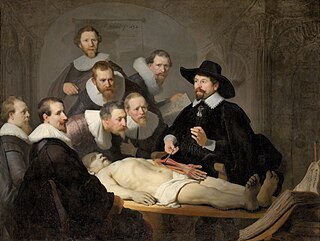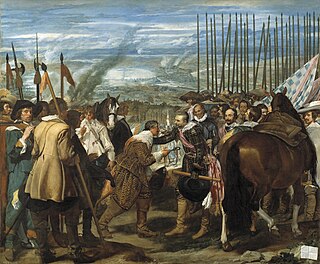
1687 (MDCLXXXVII) was a common year starting on Wednesday of the Gregorian calendar and a common year starting on Saturday of the Julian calendar, the 1687th year of the Common Era (CE) and Anno Domini (AD) designations, the 687th year of the 2nd millennium, the 87th year of the 17th century, and the 8th year of the 1680s decade. As of the start of 1687, the Gregorian calendar was 10 days ahead of the Julian calendar, which remained in localized use until 1923.

The 1620s decade ran from January 1, 1620, to December 31, 1629.
The 1630s was a decade that began on January 1, 1630, and ended on December 31, 1640.

1657 (MDCLVII) was a common year starting on Monday of the Gregorian calendar and a common year starting on Thursday of the Julian calendar, the 1657th year of the Common Era (CE) and Anno Domini (AD) designations, the 657th year of the 2nd millennium, the 57th year of the 17th century, and the 8th year of the 1650s decade. As of the start of 1657, the Gregorian calendar was 10 days ahead of the Julian calendar, which remained in localized use until 1923.

1650 (MDCL) was a common year starting on Saturday of the Gregorian calendar and a common year starting on Tuesday of the Julian calendar, the 1650th year of the Common Era (CE) and Anno Domini (AD) designations, the 650th year of the 2nd millennium, the 50th year of the 17th century, and the 1st year of the 1650s decade. As of the start of 1650, the Gregorian calendar was 10 days ahead of the Julian calendar, which remained in localized use until 1923.

1685 (MDCLXXXV) was a common year starting on Monday of the Gregorian calendar and a common year starting on Thursday of the Julian calendar, the 1685th year of the Common Era (CE) and Anno Domini (AD) designations, the 685th year of the 2nd millennium, the 85th year of the 17th century, and the 6th year of the 1680s decade. As of the start of 1685, the Gregorian calendar was 10 days ahead of the Julian calendar, which remained in localized use until 1923.

1632 (MDCXXXII) was a leap year starting on Thursday of the Gregorian calendar and a leap year starting on Sunday of the Julian calendar, the 1632nd year of the Common Era (CE) and Anno Domini (AD) designations, the 632nd year of the 2nd millennium, the 32nd year of the 17th century, and the 3rd year of the 1630s decade. As of the start of 1632, the Gregorian calendar was 10 days ahead of the Julian calendar, which remained in localized use until 1923.

1630 (MDCXXX) was a common year starting on Tuesday of the Gregorian calendar and a common year starting on Friday of the Julian calendar, the 1630th year of the Common Era (CE) and Anno Domini (AD) designations, the 630th year of the 2nd millennium, the 30th year of the 17th century, and the 1st year of the 1630s decade. As of the start of 1630, the Gregorian calendar was 10 days ahead of the Julian calendar, which remained in localized use until 1923.

1625 (MDCXXV) was a common year starting on Wednesday of the Gregorian calendar and a common year starting on Saturday of the Julian calendar, the 1625th year of the Common Era (CE) and Anno Domini (AD) designations, the 625th year of the 2nd millennium, the 25th year of the 17th century, and the 6th year of the 1620s decade. As of the start of 1625, the Gregorian calendar was 10 days ahead of the Julian calendar, which remained in localized use until 1923.

1627 (MDCXXVII) was a common year starting on Friday of the Gregorian calendar and a common year starting on Monday of the Julian calendar, the 1627th year of the Common Era (CE) and Anno Domini (AD) designations, the 627th year of the 2nd millennium, the 27th year of the 17th century, and the 8th year of the 1620s decade. As of the start of 1627, the Gregorian calendar was 10 days ahead of the Julian calendar, which remained in localized use until 1923.

1628 (MDCXXVIII) was a leap year starting on Saturday of the Gregorian calendar and a leap year starting on Tuesday of the Julian calendar, the 1628th year of the Common Era (CE) and Anno Domini (AD) designations, the 628th year of the 2nd millennium, the 28th year of the 17th century, and the 9th year of the 1620s decade. As of the start of 1628, the Gregorian calendar was 10 days ahead of the Julian calendar, which remained in localized use until 1923.

1629 (MDCXXIX) was a common year starting on Monday of the Gregorian calendar and a common year starting on Thursday of the Julian calendar, the 1629th year of the Common Era (CE) and Anno Domini (AD) designations, the 629th year of the 2nd millennium, the 29th year of the 17th century, and the 10th and last year of the 1620s decade. As of the start of 1629, the Gregorian calendar was 10 days ahead of the Julian calendar, which remained in localized use until 1923.

1638 (MDCXXXVIII) was a common year starting on Friday of the Gregorian calendar and a common year starting on Monday of the Julian calendar, the 1638th year of the Common Era (CE) and Anno Domini (AD) designations, the 638th year of the 2nd millennium, the 38th year of the 17th century, and the 9th year of the 1630s decade. As of the start of 1638, the Gregorian calendar was 10 days ahead of the Julian calendar, which remained in localized use until 1923.

1635 (MDCXXXV) was a common year starting on Monday of the Gregorian calendar and a common year starting on Thursday of the Julian calendar, the 1635th year of the Common Era (CE) and Anno Domini (AD) designations, the 635th year of the 2nd millennium, the 35th year of the 17th century, and the 6th year of the 1630s decade. As of the start of 1635, the Gregorian calendar was 10 days ahead of the Julian calendar, which remained in localized use until 1923.

1637 (MDCXXXVII) was a common year starting on Thursday of the Gregorian calendar and a common year starting on Sunday of the Julian calendar, the 1637th year of the Common Era (CE) and Anno Domini (AD) designations, the 637th year of the 2nd millennium, the 37th year of the 17th century, and the 8th year of the 1630s decade. As of the start of 1637, the Gregorian calendar was 10 days ahead of the Julian calendar, which remained in localized use until 1923.
Year 1480 (MCDLXXX) was a leap year starting on Saturday of the Julian calendar.

1590 (MDXC) was a common year starting on Monday of the Gregorian calendar and a common year starting on Thursday of the Julian calendar, the 1590th year of the Common Era (CE) and Anno Domini (AD) designations, the 590th year of the 2nd millennium, the 90th year of the 16th century, and the 1st year of the 1590s decade. As of the start of 1590, the Gregorian calendar was 10 days ahead of the Julian calendar, which remained in localized use until 1923.

1706 (MDCCVI) was a common year starting on Friday of the Gregorian calendar and a common year starting on Tuesday of the Julian calendar, the 1706th year of the Common Era (CE) and Anno Domini (AD) designations, the 706th year of the 2nd millennium, the 6th year of the 18th century, and the 7th year of the 1700s decade. As of the start of 1706, the Gregorian calendar was 11 days ahead of the Julian calendar, which remained in localized use until 1923.

1699 (MDCXCIX) was a common year starting on Thursday of the Gregorian calendar and a common year starting on Sunday of the Julian calendar, the 1699th year of the Common Era (CE) and Anno Domini (AD) designations, the 699th year of the 2nd millennium, the 99th year of the 17th century, and the 10th and last year of the 1690s decade. As of the start of 1699, the Gregorian calendar was 10 days ahead of the Julian calendar, which remained in localized use until 1923.

Year 1559 (MDLIX) was a common year starting on Sunday of the Julian calendar.
























